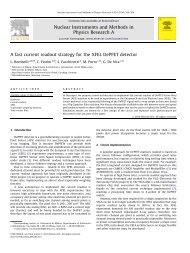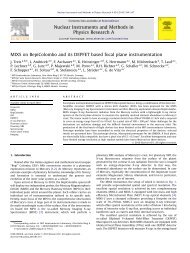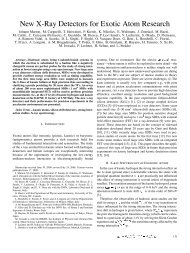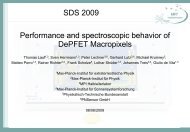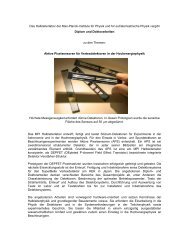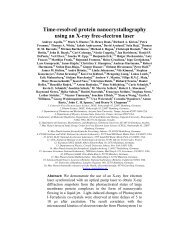Gamma-ray Spectroscopy with LaBr3:Ce Scintillator ... - MPG HLL
Gamma-ray Spectroscopy with LaBr3:Ce Scintillator ... - MPG HLL
Gamma-ray Spectroscopy with LaBr3:Ce Scintillator ... - MPG HLL
You also want an ePaper? Increase the reach of your titles
YUMPU automatically turns print PDFs into web optimized ePapers that Google loves.
value of output capacitance. In this case R el can be<br />
significantly low, <strong>with</strong>out using an internal multiplication<br />
mechanism. The statistical contribution is kept close to the<br />
pure Poisson limit thanks to both the high quantum efficiency<br />
of the photodetector, and by the absence of the multiplication,<br />
so that α = 1 (see Table 1).<br />
If we plot the energy resolution vs. γ-<strong>ray</strong> energy, as shown<br />
in Fig.1, there is a low-energy region where the electronic<br />
contribution is expected to be dominant, if present, like in<br />
APDs and SDDs; then we find a region dominated by the<br />
statistical contribution, and in this case the SDD is expected to<br />
have better energy resolution performances <strong>with</strong> respect to the<br />
other photodetectors. Finally there is a region where the<br />
intrinsic contribution of the scintillator is dominant. In this<br />
case, the choice of the photodetector has no significant effect.<br />
II. THE SDD DETECTOR<br />
The Silicon Drift Detector is a silicon detector,<br />
characterized by a particular charge collection mechanism,<br />
such as the electrons generated in the active area of the device<br />
drift towards the anode, which has a small size and a very<br />
small capacitance, independent from the total active area of<br />
the device. Equation 2 expresses the ENC of the detector, as a<br />
function of the shaping time used for signal processing.<br />
2 2<br />
⎛ A<br />
⎞<br />
1<br />
ENC = C<br />
T<br />
⎜ a + A2<br />
2 πa<br />
f<br />
+ A3τb<br />
τ<br />
⎟<br />
(2)<br />
⎝ s<br />
⎠<br />
In this equation C T is the value of the total anode<br />
capacitance (detector + preamplifier + parasitic), τ s is the<br />
shaping time, a is the white series noise, a f is the 1/f noise<br />
coefficient and b is the white parallel noise due to the leakage<br />
current, which can be reduced by cooling. From (2) it can be<br />
seen that a small value of C T reduces the electronic noise<br />
<strong>with</strong>out the need of a multiplication mechanism. Moreover, as<br />
the ENC is dependent on the shaping time, there is an<br />
optimum value for this parameter, which is usually of the<br />
order of 1 μs for the SDDs (this value is dependent on the<br />
operating temperature).<br />
SDDs used for scintillation readout have already<br />
demonstrated to achieve state-of-the-art energy resolution in<br />
γ-<strong>ray</strong> spectroscopy using a CsI:Tl scintillator [8] as well as<br />
sub-millimetre position resolution in γ-<strong>ray</strong> imaging [9].<br />
However, the use of a slow scintillator like CsI:Tl (decay time<br />
~1 μs) did not allow to fully exploit the best noise<br />
performances offered by the SDD, which are obtained using<br />
shaping times of the order of 1 μs. Longer shaping times were<br />
needed <strong>with</strong> CsI:Tl for not being excessively affected by<br />
ballistic deficit. In this case, the electronic noise of the SDD<br />
was dominated by the contribution of the leakage current<br />
(white parallel noise, see (2)) which had to be reduced by<br />
cooling.<br />
The recently introduced LaBr 3: <strong>Ce</strong> scintillator has a much<br />
shorter decay time, of the order of 25 ns, which does not<br />
generate ballistic deficit, even when used at shaping times of 1<br />
μs or less. This benefit has however to be considered together<br />
<strong>with</strong> the collection mechanism of the scintillation-generated<br />
charge inside the SDD. In fact, the drift time necessary for the<br />
charge to reach the anode of the photodetector prevents the<br />
use of a too short shaping time. For the device presented in the<br />
next section, the drift time from the outermost region of the<br />
active area is estimated to be about 0.7μs.<br />
III. DETECTOR CHARACTERIZATION<br />
The detector we have used for the measurements is a<br />
circular SDD, <strong>with</strong> an active area of 30mm 2 , produced at the<br />
Semiconductor Laboratory of Max Planck Institut in Munich.<br />
The light enters from the bottom side of the detector, which is<br />
made by an homogeneous entrance window. The input JFET<br />
of the readout electronics has been integrated in the detector<br />
itself, in order to further reduce the total anode capacitance,<br />
and consequently the electronic noise at short shaping times.<br />
Recent technological improvements in the fabrication process<br />
of the SDD include a reduced leakage current, of about<br />
200pA/cm 2 at 25°C, which makes the device very attractive<br />
for measurements near room temperature. Another feature is<br />
the presence of the bonding pads outside the active area; a<br />
layout of the chip is shown in Fig. 2.<br />
The principle schematic of the readout electronics used in<br />
the measurements <strong>with</strong> the SDD is shown in Fig.3. The JFET<br />
integrated on the detector is operated in a source follower<br />
configuration <strong>with</strong> an external current source. The voltage<br />
signal is obtained by the conversion of the charge signal into<br />
voltage on the total capacitance C d connected at the detector<br />
output. The signal is amplified by means of a voltage<br />
amplifier. This is realized by means of a coupling capacitor<br />
followed by a charge preamplifer. The voltage gain on the<br />
signal step is given by C K /C F while the decay time of the<br />
preamplifier waveform is equals to R F C F . The signal is further<br />
processed by a Tennelec TC244 shaping amplifier.<br />
The electronic noise of the device have been characterized<br />
by directly irradiating the device <strong>with</strong> an X-<strong>ray</strong> source of 55 Fe<br />
(5.9 KeV Mn Kα), at different temperatures, ranging from -<br />
10°C to 23°C. The optimum energy resolution achieved was<br />
145 eV FWHM (9.8 e - rms), obtained at -10°C and <strong>with</strong> a<br />
shaping time of 1 μs. At room temperature we obtained 237<br />
eV FWHM at 0.25 μs. The corresponding spectra are shown<br />
in Fig. 4.<br />
If we plot the measured electronics noise <strong>with</strong> respect to<br />
the shaping time we find a behavior, in accordance to (2),<br />
which is shown in Fig. 5. It is also worth mentioning that the<br />
shaping times compatible <strong>with</strong> LaBr 3: <strong>Ce</strong> correspond roughly<br />
to the minimum of the ENC curve, while the CsI:Tl lays in a<br />
region <strong>with</strong> higher noise, especially at room temperature.<br />
The entrance window of the detector was also provided<br />
<strong>with</strong> custom anti-reflective coatings (ARCs). The presence of<br />
these coatings is important, because they improve the<br />
Quantum Efficiency η at the wavelengths of interest,<br />
increasing the collected signal charge, and, from (1), this has<br />
positive effects both on the electronic contribution R el and on<br />
the statistical contribution R st . A plot of the measured η vs.



